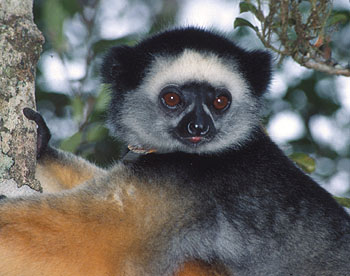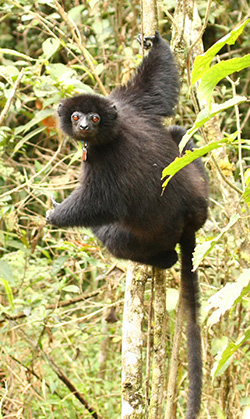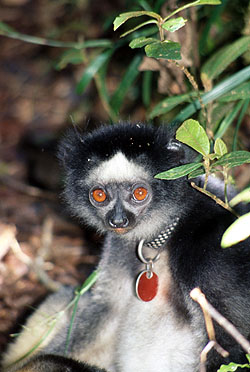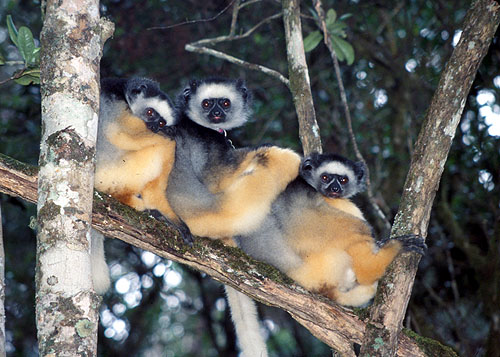Study Species: Propithecus diadema
|
Sifakas (family Indriidae, genus Propithecus) are a group of lemurs found only in Madagascar and distributed throughout the island except for the high plateau. There are nine species in all: four species occupying the drier forests of the south, southwest and west (and parts of the central plateau), four species occupying the rainforests of the east, and the monotypic P. tattersalli occupies a small range in the northeast. One of the four rainforest species is Propithecus diadema, the diademed sifaka. Foliage is usually the major component of sifaka diets, although fruits and seeds can play a major role, especially in the rainy season. In fact, although they are generally considered folivores because of their extensive adaptations to leaf-eating (including specialized, cresty teeth and a voluminous gastrointestinal tract for hindgut fermentation), many populations seem to prefer fruits or seeds when they are available. In 1999, a previously unknown local variant of Propithecus diadema (known as “sadabe”) was documented at Tsinjoarivo by Steve Goodman and Harald Schütz, and a brief Duke University capture expedition was led by Ken Glander shortly afterwards. I began my study of this population at Tsinjoarivo in 2001. Tsinjoarivo sifakas have certain morphological differences compared to other diademed sifakas: they are smaller, and their pelage is qualitatively distinct, having a duller yellow-orange color on the limbs, much less white hair surrounding the face and ears, and (variably) black patches extending onto the ventral aspect of the forelimbs and hindlimbs. Several melanistic individuals have been documented, and being part of long-term study gropus, they are clearly not hybrids. However, genetic analyses to date haven't shown substantial genetic differentiation among the P. diadema populations. The diademed sifaka is recognized by the IUCN as critically endangered, the highest possible risk category, based on its relatively low population density, substantial decline in habitat, and hunting pressure. |
 The adult male in group CONT1 |
At Tsinjoarivo, sifakas live in small social groups of 2-9 individuals. Groups have one breeding adult male, 1-2 breeding adult females, and multiple immature offspring. Breeding is strictly seasonal, with mating occurring in December and births occurring in June/July. In the groups with multiple breeding females, these tend to be mother-daughter pairs, and sometimes the two females share infant-carrying duties. As with other sifakas, females are dominant over males, and it is fairly common to see females displace males at feeding sites. |
Four groups were examined for the 2003 behavioral study: two in continuous forest at Vatateza (CONT1, CONT2), and two in fragments at Mahatsinjo (FRAG1, FRAG2). The four study groups were habituated during November and December 2002, and after habituation could be observed reliably at close distances. Over the years we have lost two study groups, one of which (FRAG1) was decimated by fosa (Cryptoprocta ferox) predation. We now track nine study groups: three at Vatateza, four at Mahatsinjo, and two at an intermediate site, Ankadivory.
|
|
 |
 A juvenile male resting on the ground, group CONT2 |
Beginning in November 2002, we have humanely captured several study animals in collaboration with wildlife veterinarians. 1-2 animals per group are given radiocollars (weight ≤ 35 g), and other animals are given colored olefin collars and metal pendants. The capture database has revealed that many sifakas living in fragmented and disturbed habitat have body mass similar to those living in more intact habitat - but certain fragments below a threshold of habitat quality show that adults are skinniers, and immatures have stunted growth. |

